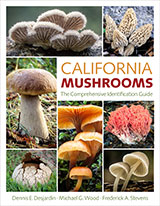The North American Species of Pholiota
29. Pholiota gummosa (Lasch) Singer, Lilloa 22: 517. 1951.
Agaricus gummosus Lasch, Linnaea 3: 406. 1828.
Flammula gummosa (Lasch) Kummer, Der Führer in die Pilzkunde, p. 82, 1871.
Dryophila gummosa (Lasch) Quélet, Enchir. Fung. p. 70. 1886
Illustrations: Text figs. 62-64.
Pileus 2-5 cm broad, at first hemispheric, then convex, mamillate at first but generally obtuse or even slightly depressed in age, with the margin inrolled and regular but often becoming straight or irregularly undulating, when young slightly greenish, then clear pale citrine, showing often reddish to brownish red on disc, at times uniformly of these colors in age, viscid at first, then dry, decorated with brownish squamules very appressed and often not apparent at maturity. Context fairly thin, clear yellow, odor of herbs, taste mild or slightly raphanoid.
Lamellae merely close, unequal, adnate to appearing slightly decurrent, fairly narrow (3-7 mm), pale yellow finally yellowish brown with paler edges.Stipe 3.5-8 cm long, 3-8 mm thick, pliant, cylindric to crooked or twisted, in some attenuated downward, stuffed, at first yellowish pallid to clear citrine, becoming rusty (tawny) below, with traces of reddish mycelium, decorated with zones and patches of veil remnants. Cortina yellowish pallid, remains disappearing almost entirely.
Spores 5.5-7 X 3.5-4 µ, smooth, apical pore distinct but apex not truncate; shape in face view ellipsoid, in profile oblong to ellipsoid; color in KOH dark yellow brown, in Melzer's paler; wall 0.25 µ thick.
Basidia 4-spored, 18-20 x 6-7 µ, clavate, hyaline in KOH, yellowish in Melzer's reagent. Pleurocystidia none, except for clavate bodies with ochraceous content in KOH. Cheilocystidia filamentous 24-36 X 5-8 µ, broadest at capitate apex, hyaline, smooth, thin-walled, content homogeneous. Caulocystidia 28-42 X 7-12 µ clavate, subutriform or more rarely fusoid ventricose, smooth, thin-walled, hyaline, arising from a gelatinous subhymenium over apex of stipe, content hyaline but coagulated and wrinkled in some cells.
Gill trama with a central area of hyaline subparallel floccose hyphae 4-12 µ diam. walls thin, smooth, hyaline; subhymenium a distinct gelatinous interwoven layer of narrow hyaline hyphae. Pileus cutis a well developed layer of narrow gelatinous hyphae 3-5 µ diam. smooth, hyaline in KOH; hypodermial zone not distinct. Context hyphae interwoven, hyphae with inflated cells, walls thin, smooth, hyaline in KOH. Clamp connections present. All hyphae inamyloid.Habit, Habitat, and Distribution: Romagnesi reports it as fairly common in the spring or fall on wood or soil.
Observations: Kühner & Romagnesi (1953) and Romagnesi (1956 pl. 58 lower figs.) describe a species which they consider to have chrysocystidia. In our mounts we did not find any with the hyaline refractive inclusion as revived in KOH, but some clavate cells with yellow content were observed. In either case, depending on ones definition of chrysocystidia, the species would not fall in section Lubrica of Singer or in our subgenus Flammuloides. Our description is translated and condensed from that of Romagnesi (1956) and our microscopic data are from excellent specimens by Josserand. We do not recognize the species, in this concept, from North America, but include the description for comparative purposes. The name has appeared in the American literature, mostly for a cystidiate species with yellowish gills but otherwise very close to P. lenta. From Romagnesi's painting it appears that P. gummosa (as Dryophila) resembles clusters of Naematoloma fasiculare on the one hand (except for the viscid pileus and lack of green gills) or greenish clusters of P. polychroa. Pilat (1959) illustrates elongate cystidia of the P. lenta type (pl. 130, as Flammula gummosa). We have used here the most clearly established concept of the species we could find by European authors. We do not insist it is the concept of Fries since none of the illustrations—Pilat's or Romagnesi's closely resemble the Friesian paintings. Kühner (1946) has studied the species in culture. He describes allocystidia in his cultures of both diploid and haploid mycelium. They remind one of the cheilocystidia of some of the species we have included in the present work.

